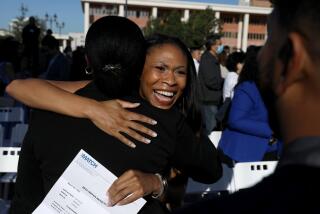Harsh Words for the Healers, High Hopes for Computers
- Share via
In Medical School by Melvin Konner (Elisabeth Sifton/Viking: $19.95; 390 pages)
Melvin Konner, now 41, was teaching anthropology at Harvard when, at age 34, he entered the Flexner School of Medicine, a fictitious name for the institution where he earned his MD. Konner says that he has “ . . . tried to offer . . . vivid descriptions . . . of medical training leading . . . to the MD degree, with the emphasis on clinical work . . . (in) . . . the institution of which I have had direct experience, including two leading medical schools. . . .”
His colorful “descriptions” comprise most of this book. With some exceptions, they depict Konner’s teachers (both faculty and residents) as arrogant, narrow-minded, ungracious or even brutal, and sometimes dishonest:
“A young surgeon in charge of the Trauma Service . . . was arrogant, blustering . . . “; “Dr. Parker . . . was reflexive and harsh . . . tense, defensive, and shrill . . . loud, pompous . . . “; “The residents had done a belly tap in the wrong place. They had failed to rule out retroperitoneal bleeding . . . “ (which, be it noted, cannot be ruled out by a “belly tap” in any place); a medical resident, “Sally Brass,” was “ . . . vulgar . . . abrasive and difficult . . . abusive . . . “; “Gross was a senior medical resident . . . a budding superdoc, humorless, arrogant, self-centered, no doubt destined for the chairmanship of a major department of medicine . . . “; “Marty Wentworth, the . . . intimidating chief surgical resident . . . had confused and insulted a . . . young doctor. . . . It was not just bad teaching; it was bad medicine.”
‘Eternal Adolescents’
Konner describes a few doctors he liked, but most of them, he believes, “Despite their impressive experience and heavy responsibilities . . . remain eternal adolescents . . . .” He acknowledges that when he is in trouble, he “will go to them, and they will improve my chances.” But he decided not to take an internship, and would not want his son or daughter to be or to marry a doctor.
Konner seems certain that his observations as a medical student and his anthropological skills have revealed generic truths about medical education in the United States. “This,” he says without qualification or hesitation, “is the world of medical training leading to the MD degree. . . .”
Is it? Or has Konner told us, perhaps unwittingly, more about himself than about his subject? No matter how bright the student, learning the art of medicine requires many years of experience with sick individuals in frequently stressful settings. Beginning that experience at age 34, with many tutors who are much younger, and simultaneously writing an anthropology book, might add to the stress.
Konner felt that he was surrounded by adversaries, but that feeling is not conducive to a balanced evaluation either of complicated clinical situations or of the human beings at work in those situations.
A More Kindly Recollection
While every medical student sometimes resents some of his teachers and the demanding craft he has undertaken to learn, relatively few feel as invincibly and righteously antagonistic as Konner does. Most students in their residency years--which Konner has not even begun--look back upon their clerkships with a more kindly feeling for teachers who once seemed prickly or worse.
All of this is not to say that the teaching of clinical medicine cannot or should not be improved, or that none of Konner’s criticism is valid. However, Konner’s account--which he believes was the result of “ . . . a full and frank subjectivity”--is intemperate and idiosyncratic. It is unlikely to be helpful to the numerous medical faculties currently engrossed in planning and making curricular changes.
In his conclusions, Konner sees profound virtue in his own work, but little hope for improvement of the “healing artisans.” The latter, he thinks, unlike “graduate students,” are trapped by a mountain of facts and mandatory lack of originality. “All 15,000 graduating medical students, given the same patient, ideally should perform the same examination, write the same assessment, and formulate the same options for treatment.”
Konner thinks that no one can really learn all those facts, and he looks for deliverance, reasonably soon, when hand-held computers replace the “successful medical students and physicians . . . who have great memories but lack much else. . . .”
Based Upon a Fallacy
This formulation is based upon a fallacy--that “assessment” of a patient by a physician requires only established “facts,” which are in the library. In practice, many “facts” indispensable for the “assessment” are not in the library. They are inferences from the patient’s story and appearance, sometimes gleaned with both skill and scientific reasoning from individual circumstances that may camouflage the diagnosis.
Konner’s formulation suggests to me that its author never quite got the hang of taking a patient’s history, never understood how to interpret the language of an individual’s pain, to match facial expressions no computer can comprehend with reflexive tensing of the abdominal wall, or to catch the lumbering gallop of a weary heart.
If a medical student has not learned his craft in four years, the reason could be the hostility and cultural ignorance of mean-spirited teachers. Or it could be, as Konner seems to think, that this craft cannot be learned except by computers. The most likely reason, however, is that even the best admissions committees occasionally make a mistake.
More to Read
Sign up for our Book Club newsletter
Get the latest news, events and more from the Los Angeles Times Book Club, and help us get L.A. reading and talking.
You may occasionally receive promotional content from the Los Angeles Times.








